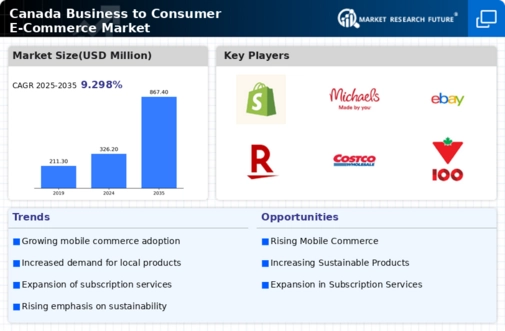Growing Internet Penetration
The increasing accessibility of the internet is a pivotal driver for the business to-consumer-e-commerce market in Canada. As of November 2025, over 90% of Canadians have access to high-speed internet, facilitating seamless online shopping experiences. This widespread connectivity enables consumers from various demographics to engage with e-commerce platforms, thereby expanding the potential customer base for businesses. Furthermore, the rise of mobile internet usage, which accounts for approximately 60% of all online transactions, underscores the importance of optimizing e-commerce sites for mobile devices. This trend suggests that businesses that adapt to the growing internet penetration are likely to thrive in the competitive landscape of the business to-consumer-e-commerce market.
Shift in Consumer Preferences
Consumer preferences are evolving, significantly impacting the business to-consumer-e-commerce market in Canada. A growing number of consumers are prioritizing convenience, speed, and variety in their shopping experiences. Recent surveys indicate that nearly 75% of Canadians prefer online shopping due to its convenience compared to traditional retail. This shift is prompting businesses to enhance their online offerings, including faster delivery options and diverse product selections. Additionally, the demand for subscription services and personalized shopping experiences is on the rise, indicating that businesses must adapt to these changing preferences to remain competitive in the business to-consumer-e-commerce market.
Impact of Social Media Marketing
Social media platforms are playing an increasingly influential role in the business to-consumer-e-commerce market in Canada. With over 80% of Canadians actively using social media, businesses are leveraging these platforms to reach potential customers effectively. Social media marketing strategies, including influencer partnerships and targeted advertisements, are becoming essential for driving traffic to e-commerce sites. Data suggests that approximately 50% of Canadian consumers have made purchases directly through social media channels, highlighting the importance of integrating social media into e-commerce strategies. This trend indicates that businesses that harness the power of social media are likely to enhance their visibility and sales in the business to-consumer-e-commerce market.
Emphasis on Customer Trust and Security
In the business to-consumer-e-commerce market, customer trust and security are paramount. As online shopping continues to grow, consumers are increasingly concerned about data privacy and transaction security. Recent studies reveal that around 65% of Canadians are hesitant to shop online due to fears of data breaches and fraud. Consequently, businesses are prioritizing robust security measures, such as encryption and secure payment gateways, to build consumer confidence. Additionally, transparent return policies and customer service responsiveness are becoming critical factors in establishing trust. This emphasis on security and trustworthiness is likely to influence consumer choices and loyalty in the business to-consumer-e-commerce market.
Technological Advancements in E-Commerce
The business to-consumer-e-commerce market in Canada is experiencing a surge in technological advancements, which are reshaping consumer interactions and purchasing behaviors. Innovations such as artificial intelligence, augmented reality, and machine learning are enhancing the online shopping experience. For instance, AI-driven chatbots are providing real-time customer support, while augmented reality applications allow consumers to visualize products in their own space before making a purchase. According to recent data, approximately 70% of Canadian consumers express a preference for websites that utilize advanced technology to improve their shopping experience. This trend indicates that businesses investing in technology are likely to gain a competitive edge in the business to-consumer-e-commerce market.




















Leave a Comment